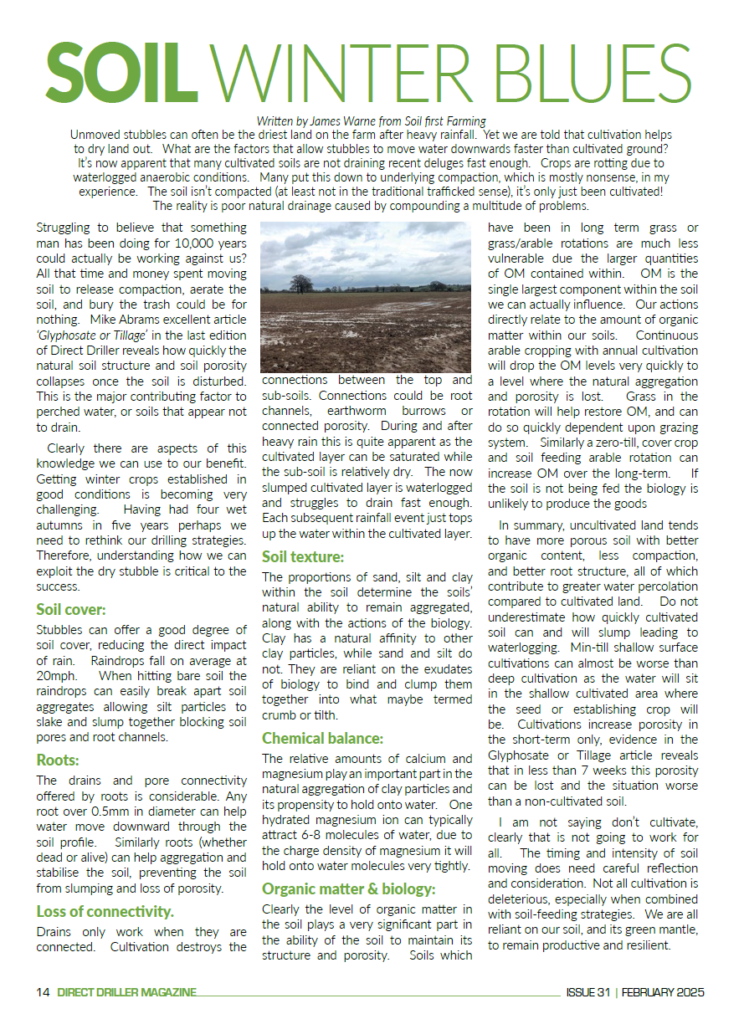Unmoved stubbles can often be the driest land on the farm after heavy rainfall. Yet we are told that cultivation helps to dry land out. What are the factors that allow stubbles to move water downwards faster than cultivated ground? It’s now apparent that many cultivated soils are not draining recent deluges fast enough. Crops are rotting due to waterlogged anaerobic conditions. Many put this down to underlying compaction, which is mostly nonsense, in my experience. The soil isn’t compacted (at least not in the traditional trafficked sense), it’s only just been cultivated! The reality is poor natural drainage caused by compounding a multitude of problems.
Struggling to believe that something man has been doing for 10,000 years could actually be working against us? All that time and money spent moving soil to release compaction, aerate the soil, and bury the trash could be for nothing. Mike Abrams excellent article ‘Glyphosate or Tillage’ in the last edition of Direct Driller reveals how quickly the natural soil structure and soil porosity collapses once the soil is disturbed. This is the major contributing factor to perched water, or soils that appear not to drain.
Clearly there are aspects of this knowledge we can use to our benefit. Getting winter crops established in good conditions is becoming very challenging. Having had four wet autumns in five years perhaps we need to rethink our drilling strategies. Therefore, understanding how we can exploit the dry stubble is critical to the success.
Soil cover:
Stubbles can offer a good degree of soil cover, reducing the direct impact of rain. Raindrops fall on average at 20mph. When hitting bare soil the raindrops can easily break apart soil aggregates allowing silt particles to slake and slump together blocking soil pores and root channels.
Roots:
The drains and pore connectivity offered by roots is considerable. Any root over 0.5mm in diameter can help water move downward through the soil profile. Similarly roots (whether dead or alive) can help aggregation and stabilise the soil, preventing the soil from slumping and loss of porosity.
Loss of connectivity.
Drains only work when they are connected. Cultivation destroys the connections between the top and sub-soils. Connections could be root channels, earthworm burrows or connected porosity. During and after heavy rain this is quite apparent as the cultivated layer can be saturated while the sub-soil is relatively dry. The now slumped cultivated layer is waterlogged and struggles to drain fast enough. Each subsequent rainfall event just tops up the water within the cultivated layer.
Soil texture:
The proportions of sand, silt and clay within the soil determine the soils’ natural ability to remain aggregated, along with the actions of the biology. Clay has a natural affinity to other clay particles, while sand and silt do not. They are reliant on the exudates of biology to bind and clump them together into what maybe termed crumb or tilth.
Chemical balance:
The relative amounts of calcium and magnesium play an important part in the natural aggregation of clay particles and its propensity to hold onto water. One hydrated magnesium ion can typically attract 6-8 molecules of water, due to the charge density of magnesium it will hold onto water molecules very tightly.
Organic matter & biology:
Clearly the level of organic matter in the soil plays a very significant part in the ability of the soil to maintain its structure and porosity. Soils which have been in long term grass or grass/arable rotations are much less vulnerable due the larger quantities of OM contained within. OM is the single largest component within the soil we can actually influence. Our actions directly relate to the amount of organic matter within our soils. Continuous arable cropping with annual cultivation will drop the OM levels very quickly to a level where the natural aggregation and porosity is lost. Grass in the rotation will help restore OM, and can do so quickly dependent upon grazing system. Similarly a zero-till, cover crop and soil feeding arable rotation can increase OM over the long-term. If the soil is not being fed the biology is unlikely to produce the goods
In summary, uncultivated land tends to have more porous soil with better organic content, less compaction, and better root structure, all of which contribute to greater water percolation compared to cultivated land. Do not underestimate how quickly cultivated soil can and will slump leading to waterlogging. Min-till shallow surface cultivations can almost be worse than deep cultivation as the water will sit in the shallow cultivated area where the seed or establishing crop will be. Cultivations increase porosity in the short-term only, evidence in the Glyphosate or Tillage article reveals that in less than 7 weeks this porosity can be lost and the situation worse than a non-cultivated soil.
I am not saying don’t cultivate, clearly that is not going to work for all. The timing and intensity of soil moving does need careful reflection and consideration. Not all cultivation is deleterious, especially when combined with soil-feeding strategies. We are all reliant on our soil, and its green mantle, to remain productive and resilient.

